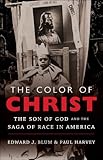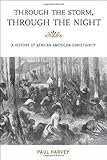Posted: 09/09/2012
During the middle of the Civil Rights movement, Mormons placed an 11-foot-tall white Jesus with an exposed powerful chest at the center of Salt Lake City. Christus, as he was originally called, was raised in 1966, but he was based upon an old Danish statue from 1821. Since '66, Christus has become a staple of Mormon iconography placed primarily in "welcome centers" all throughout the nation. He became even more poignant of a symbol after 1978, the year Mormon leadership lifted its bans on people of color from the priesthood. Blacks, Pacific Islanders and others were technically welcome in the church, but they first had to pass by the powerful white Christus.
In 2008, Jeremiah Wright's sermons about a black Jesus killed by white Romans (and its obvious analogues to present-day politics) nearly derailed his former parishioner Barack Obama's candidacy. The white Jesus of Mitt Romney's Mormon culture, by contrast, has raised no cultural firestorm. It is hardly even noticed.
So why doesn't the history of Mormonism's white Jesus spark controversy as Wright's claims about Jesus being black? Why aren't there reporters scoping about trying to understand the particular looks of Mormon Christ figures. Why did Jeremiah Wright's jeremiads and visions of a black Jesus so terrify Americans in 2008, and denunciations of black liberation theology and Obama's supposed connection to it continue to be a staple of conservative talk radio to the present day, while the powerful white imagery of the Jesus of Romney's Mormon faith arouse no interest?
Simply put: the black Jesus of American history historically has been threatening, while white Jesus imagery, at least since about the 1830s, has been so normative and dominant that it is assumed to be accurate. Historically, America's Jesus has been white without words, because whiteness needs no description. It is blackness, of the kind so prominently displayed by Jeremiah Wright's sermons replayed in 2008, that anger and trouble people, and thus need explanation.
Yet just as Wright's black Jesus had a history the media explored and tied to black liberation theology, Mormonism's white Jesus has a history connected not only to European-American assumptions that Jesus was white, but also to Mormonism's particular history. Joseph Smith didn't just translate the Book of Mormon, which contained prophecies and stories of Jesus that went well beyond traditional Christianity and that brought Christ to the Americas 1,400 years before Christopher Columbus. The young prophet also wrote of visions he had of God and Jesus. Throughout the 1830s and early 1840s, he strained to find the most accurate phrases to describe his visions In 1832, Smith recorded how he saw an "indescribable" Jesus who came in a pillar of fire and a blinding light. By the mid-1840s, the indescribable became describable. Blinding light was edited into pristine white. Smith told a follower in 1844 that Jesus had a "light complexion [and] blue eyes."
Even though Smith was in many ways an outsider in his times, his rendering of Jesus as a white man was part of a broad and sweeping transformation in pre-Civil War. He and his new church were present at and participated in the birth of the white American Christ, a move that defied the Puritan's iconoclasm of the decades and centuries before.
During the initial years of the 19th century, Americans for the first time mass-produced images of Jesus and sent them throughout the young and expanding nation. A robust industry of Jesus imagery emerged. The pictures stamped onto American minds the notion of an embodied, white Jesus. It was in these years that Jesus was first born as a sacred symbol within the United States.
From those years through the 20th century, Mormons and most white Americans depicted Jesus as white. Even after the Civil Rights Movement and globalization have forced Americans to recognize that Jesus was not white, it has not stopped the Son of God from being depicted as white on books, posters, air balloons, T-shirts and movies. In the decades since the 1960s, white Christians have been able to divorce word from image. In essence, they could sanctify whiteness with their white Jesus without saying a word.
No group performed the rhetoric-vs.-image magic better than the LDS. In 1978, they finally caved in to civil rights demands to desegregate the church and opened the priesthood to blacks. Ostensibly, this meant that blacks could become members of the church and hold positions of authority. But as it gave with one hand, the Mormon leadership took with another. In 1969, John Scott painted his "Jesus Christ visits the Americas." It was an instant hit that featured Jesus with blond hair and fair skin. He showed his wounded hands to Anglo-looking Native Americans who bowed, wept and marveled at his power. The women wore skirts and dresses that came straight from the 1960s, while the men displayed their muscular physiques. This presentation of the white Jesus and his relationship to white Native Americans became so popular that Mormon leadership had it featured in The Book of Mormon they put in hotel room dresser drawers. This was also the time when the Christus became popular.
Once born as a sacred symbol during the same years Joseph Smith and his Mormon church developed their image of Christ, the white Jesus grew to be an omnipresent part of 20th-century American popular culture. Founded (in part) by Puritans who opposed any envisioning or imagery of Jesus, America later became the greatest exporter of Jesus imagery in the world. And that imagery historically has been of the same kind of white Jesus envisioned by Smith and reproduced in countless lithographs, paintings and .jpg files since.
Even in the age of multiculturalism and a plethora of challenges to the historic iconography of the American Jesus, the white Jesus remains the norm, unnoticed and uncontroversial. For many, by contrast, the black Jesus remains the outsider, the threat, one that required Obama's full persuasive talents in reassurance in 2008 to overcome. Mitt Romney will be spared any such media firestorm.
Edward J. Blum and Paul Harvey are the authors of 'The Color of Christ: The Son of God and the Saga of Race in America' (2012).
FOLLOW RELIGION





No comments:
Post a Comment